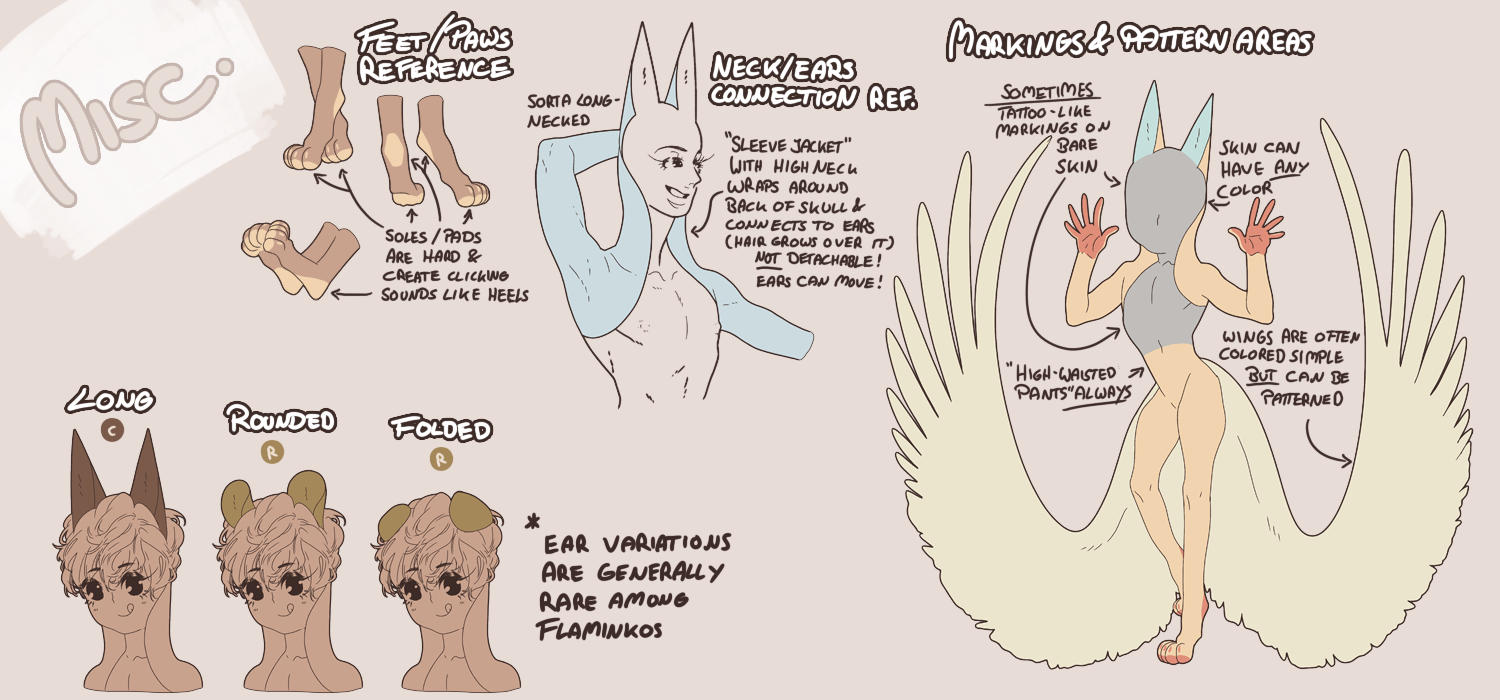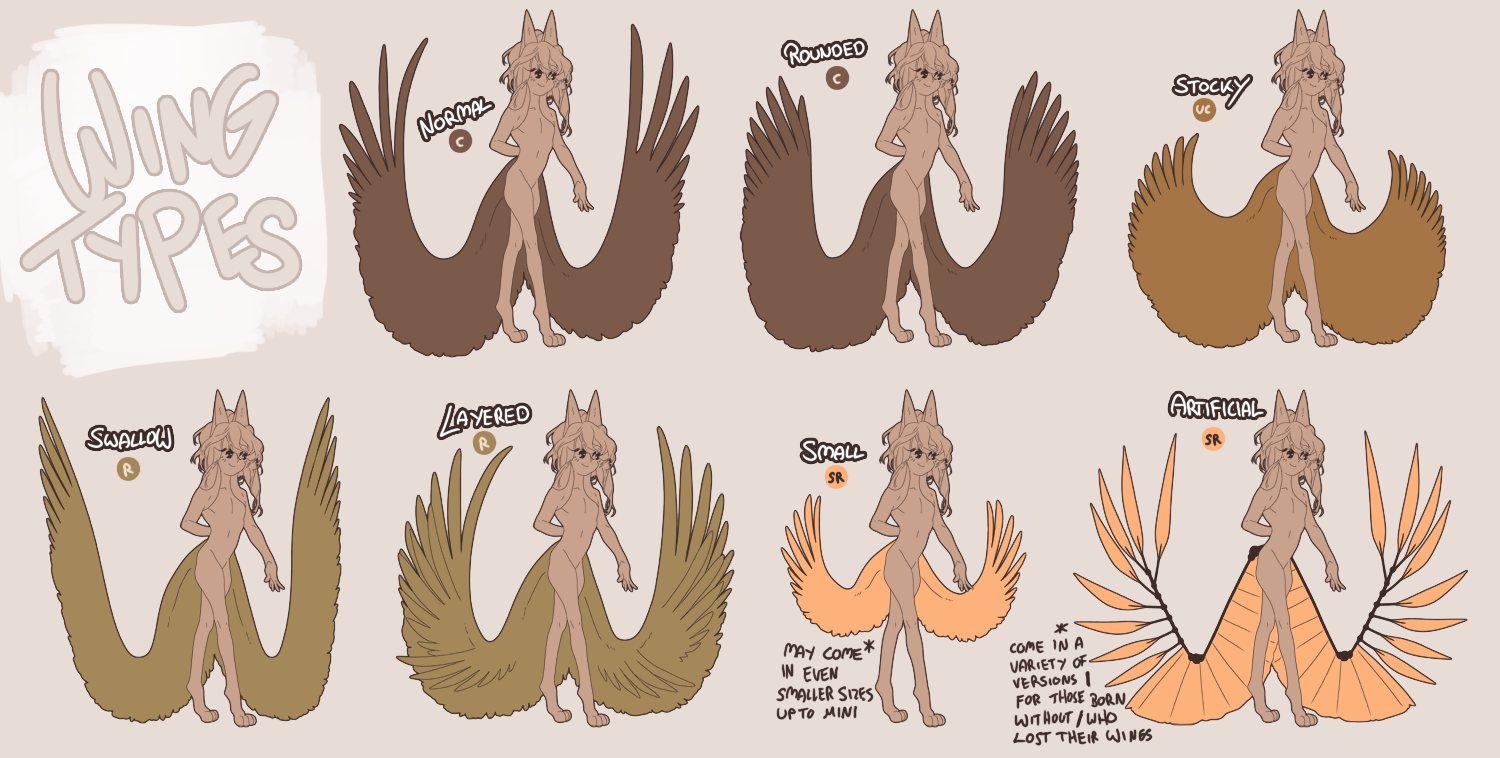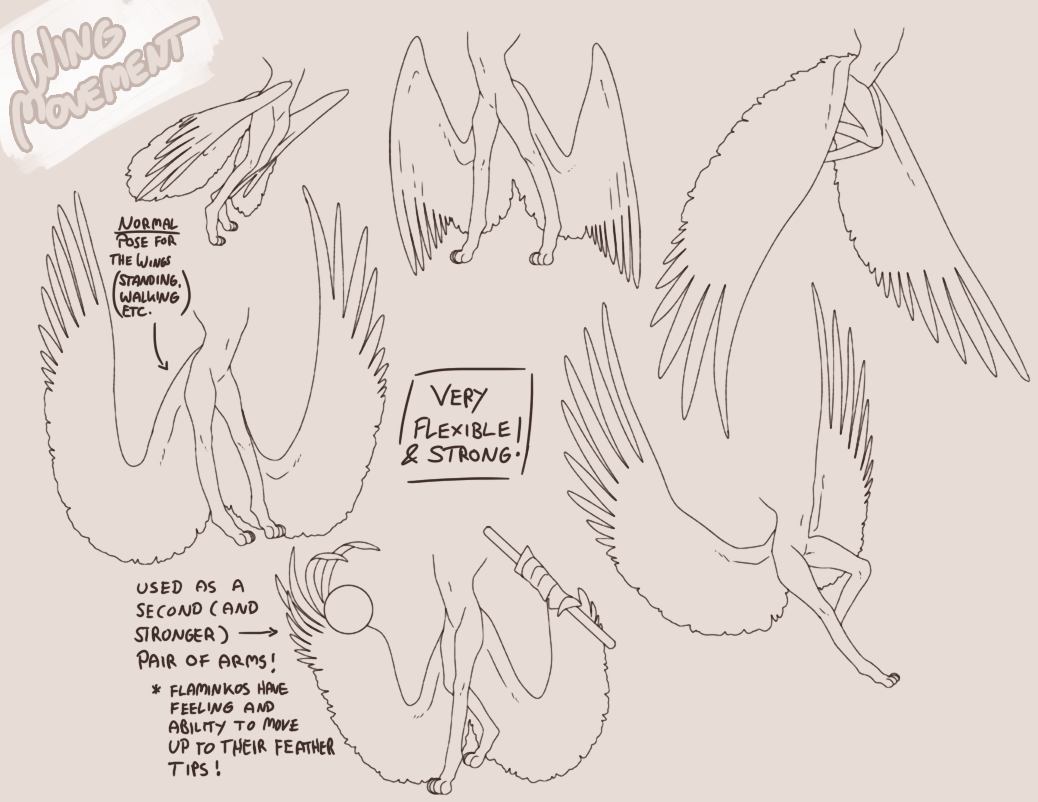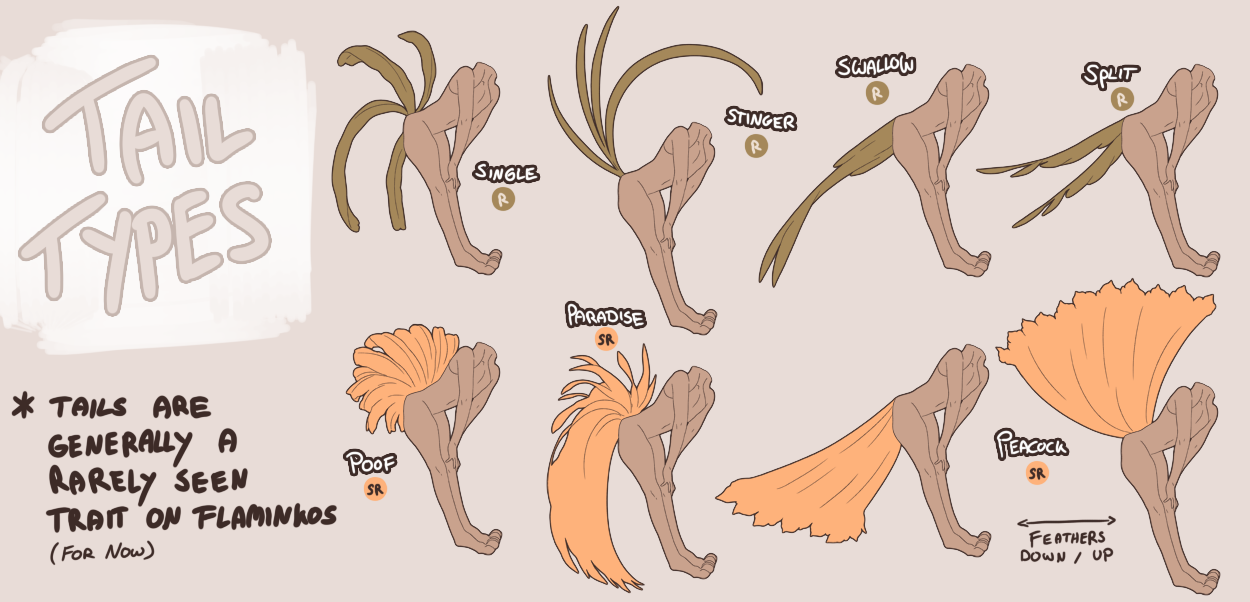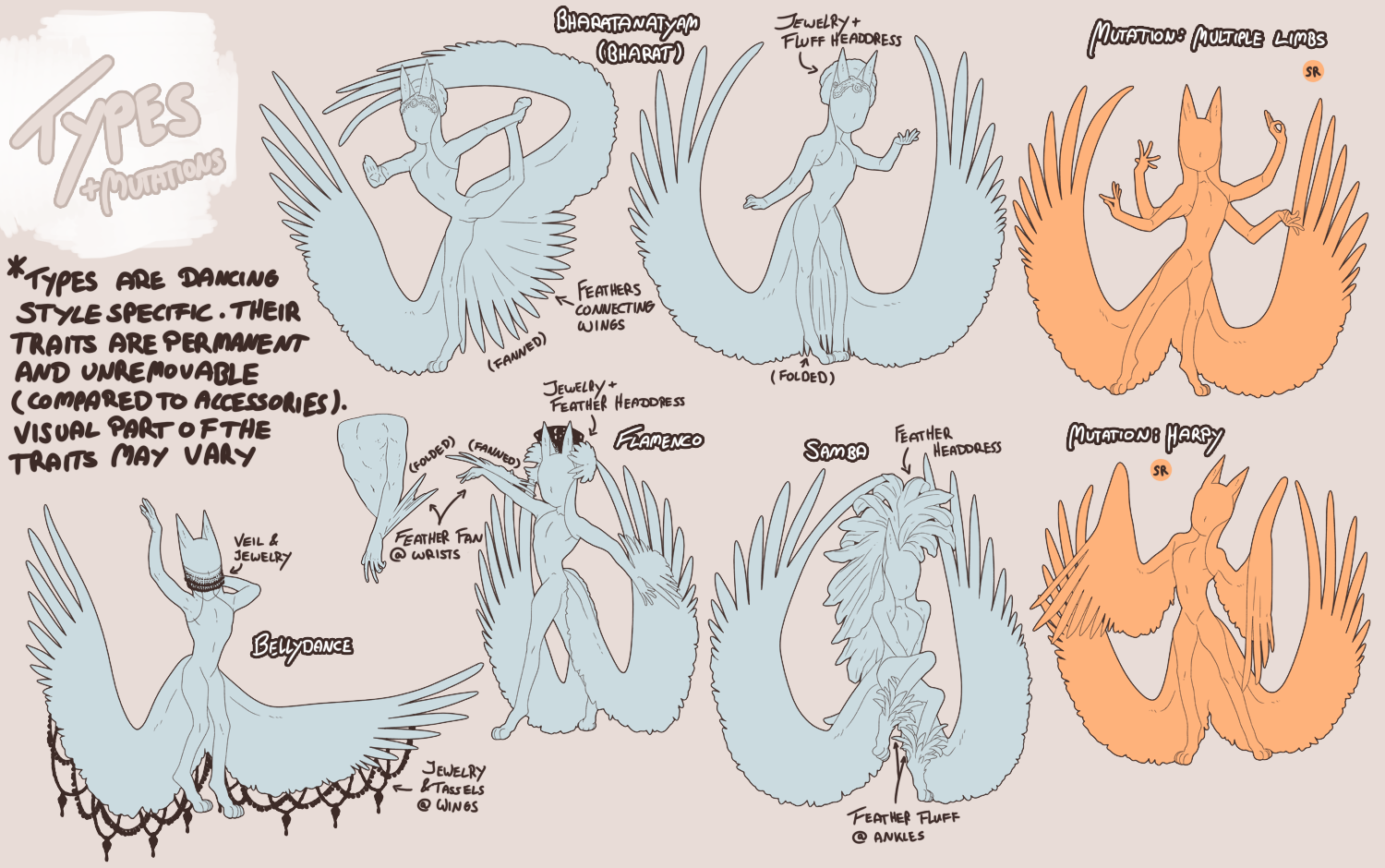heartboiledegg's Bulletins
FLAMINKOS [Flamenco + Flamingo + Ko (jp. = child)]
Flaminkos are a species known for their excelling dancing skills. Their culture’s main focus lies on latino, middle eastern and indian dances, which are used to either entertain or be of ceremonious matters, their low wings often recreating the flow of a dancing gown and adding to their graceful movements.
- sorta long necks, thin waists, thick upper thighs, strong legs
- between 5'9'' and 7'5'' tall - old records speak of Flaminkos as tall as up to 10'
- soles/pads below feet are quite hard and create clicking sounds much like heels
- their skin can have any color
- they come in all body types
- sprout from above the tailbone
- usually a wide wingspan
- very flexible & strong
- Flaminkos can feel and move their wings up to the tips of their feathers
- utilized as a second pair of arms in their daily lives, grasping or holding onto things
- surprisingly light
- Flaminkos are unable to fly as their point of balance is off, they use their wings to glide though, taking off in a run, bouncing on their feet and pushing off the ground
- when gliding Flaminkos prefer not to flap their wings as this easily tips them off their balance, they can learn to move their wings and thus glide farther however
- their wings are a Flaminko's pride
- being born without/losing their wings has destroyed many a Flaminko's life
- very rare
- if a Flaminko happens to have a tail they are adored for it all around
Most Flaminkos are born as the common type, however there are those born a type of a certain dancing style. Types are hereditary and their genes mostly recessive in a mixed type partnership.
Special type Flaminkos are often part of ancient and large family lines well-known for their otherworldly specialization in one specific dancing style (related to their type).
Special type Flaminkos are viewed in awe even among their own kin.
Mutations are very rare occurences but exist. These are usually looked at with an odd mixture of wonder and condescendence.
REPRODUCTION | RELATIONSHIPS | LIFE CYCLE
- Flaminkos are very open-minded, homosexual relationships are nothing they judge
- usually monogamous, but a few polyamorous relationships do exist
- some Flaminkos do form a relationship with humans (it is a difficult thing and thus often rather platonic/asexual)
- Flaminkos are intensely flirtatious and sensual creatues and dancing, more specifically mating dances are practiced annually
- the mating season/dances are every year's highlight for the Flaminkos and a beautiful sight to see
Reproduction is actually a somewhat rare occurence amongst Flaminkos and can only be achieved by a heterosexual pair. A pregnancy is the event for every Flaminko around the lucky couple. Flaminkos hatch from eggs which the mother bears (one at a time) in her stomach until the egg reaches ostrich size. Once it is laid the shell will break apart when the baby inside is physically ready. Freshly hatched Flaminkos resemble sphinxes as they walk on four legs, have a human face and their ears. Baby Flaminkos become bipedal within the first couple of months though, some sooner, some later.
Their growth is small while they are still on four legs, however once they hit their bipedal state they grow faster and approximately hit puberty around 7 years of age. Puberty then takes at least another 7 years and in most cases longer than that.
Toddler Flaminkos are of small stature with kinda big feet and no wings at all.
Their wings are a sign of them hitting puberty, thus when a Flaminko's wings start sprouting it's a huge deal for them. The wings start developing above the tailbone and usually break through the skin overnight. When they do the young Flaminko will have an extra deep sleep as their body spares them the pain and thus they wake up to a surprise.
Starting out as tiny, naked chicken wings the time span of how long the wings remain naked differs from Flaminko to Flaminko (which can get quite embarrassing). At first they hit a very short fuzz plume phase, at max a day long, whereafter they develop proper feathers (unless a genetic defect is present). Once the feathers set in Flaminkos definitely start showing off their small butt wings and boast plenty.
HISTORY (wip)
- way back, in old times, Flaminkos were often mistaken for angels
- Flaminkos tend to mention someone they refer to as 'Father' and 'Mother' but it is still unclear who those beings are or how they relate to the Flaminkos as a species
MAGIC (wip)
- Flaminkos do posses magic potential, it is unknown to what extent however
One well-known magic ability of the Flaminko is called 'Alboreas':
Alboreas is a song that can be heard at daybreak (alba = daybreak) and is often associated with either mourning or celebration, generally in correlation to the dawning of something new or a very recent event. Depending on the tone it can mean either.
Alboreas are only sung on special occasions. It suffices if a single Flaminko begins the song as their voice carries the emotions far and wide to their kin around them, prompting them to sing along. Thus the Alboreas is a sort of magical occurence for both Flaminkos and other species as their voices will join from the four winds and form a choir that can be heard for many a mile.
It has a serene, pure quality and often seems fragile, like a song brought by the wind.
The Alboreas allows all Flaminkos participating to share one mind, heart and soul for as long as it lasts, easing pain or sharing joy with one another.
Another art of magic Flaminkos hold is labeled 'Taraduende' (tarab + duende):
A Flaminkos dance is a very intense experience for both the dancer and the audience. Those watching will often experience an intimate, trance-like fixation or haunting feeling through the soul force that is released from the inner spirit of a Flaminko as a result of their close relationship with the music and dance. The stronger a Flaminko feels bound to the music and expresses this through their dance the more a watcher will feel. Flaminkos are less affected by Taraduende as watchers but even for them no performance ever feels the same and each emits its very own, individual vibes that can only be found once.
OCCUPATIONS
Flaminkos often find hiring as elite dancers and entertainers for other species. Anything aristocratic and tasteful suits them well if not dance or song itself.
Not few Flaminkos are also known to have a talent for instruments and will either play them themselves or create them.
Naturally there are Flaminkos with all kinds of occupations though, some even violent, but the ones above are the most common and natural for them.
MISCELLANEOUS
- actually very good runners, very agile
- will kick rather than punch someone if necessary
- when in a fight with their kin they will not resort to violence as it is very disreputable, rather they have dance-offs instead of fist fights
- fancy anything exquisite, rhythmic and elegant
- they are prideful people
- made for warm climates and despise the cold
- they can't stand an uneventful or boring life and will go seek adventure if they must
- very sociable and usually talkactive, too
- if a Flaminko loses their ability to dance, much like the case of their wings, they will fall into bottomless misery
- they do have their own language but tend to speak in a tongue that is understandable by most other species
EXAMPLE
Flaminkos are a closed species by @BJ-LIPS.
Please do not create your own.
